The Story of our
Stained Glass Windows

The beautiful stained glass picture window of Jesus Christ holding a lost lamb is almost eighty years old. It was presented and dedicated to the new church back on August 30, 1929 by Mrs. O. C. Peterson in memory of her son Oswald Peterson. At that time, our church had 25 to 30 families with around 50 children enrolled in Sunday school. Back then we had an active, confirmed membership of 70 members. In 1959, when our current church was built, the stained glass picture was reinstalled in the hallway. We currently have 796 baptized members, 625 confirmed members, and we have a Sunday school enrollment of about 70.
The Windows of
First Lutheran Church
The stained glass windows of First Lutheran Church capture symbolically the essence of the “story of salvation” as found in the Bible and in the Church. Three major themes are detected as one moves from the left front corner back along the nave and then from the right front window to the back. These themes parallel the major professions of the Apostle’s Creed, moving from Creation to Redemption and Sanctification in the life of the Church. The left side is depicted as our Lord’s first half of the church year, wherein fall the festivals of Christmas, Easter and Pentecost. The right side is depicted as the Church’s half of the church year, the Church preaching, teaching and sharing the Gospel through Word and Sacrament.
Dominant in each of the windows is the large royal blue, fish like shaped symbol. It reminds us of the dominant color in God’s creation, the sky which arches over the world and the water which makes up over 2/3 of this planet’s space. Blue is also the color of hope and loyalty. Out of the waters of our Baptism, God has promised His faithfulness to us, always.
As mentioned, the large blue symbol is shaped like a fish, with little fins (red accents). The Greek word, ICTHUS, means the sign of the fish. In its early years when Christianity was a persecuted religious group, it was the code symbol Christians used to identify each other, a sign of unity. Christians could be in any city of the empire, being hounded, lost, or in trouble, and they would know that in the sign of the fish, they would find people who would be as brothers and sisters, even though their language, skin color, or ethnic culture might be different. They were people united in their faith that Jesus Christ was God’s Son, our Savior. Their motto was, “Watch for the sign of the fish, you can trust it.” Like the windows, they were united by the sign of the fish.
The windows on the left side begin with the Creation and the Fall of man and then move on to the redemption (salvation) of God through Jesus Christ. In the third window the fulfillment of God’s promise is noted in the Incarnation (manger). The last four of the left windows portray the Transfiguration of Christ as God’s living Word, the ultimate redemptive act of God through Christ in His death upon the Cross, victory over the grave, and the sending of His seven fold Spirit to the Church.
CREATION AND FALL
(Windows 1 and 2)
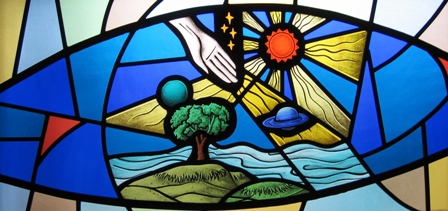
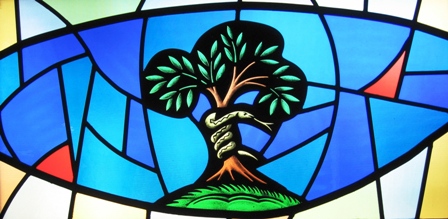
“I believe in God the Father Almighty, Creator of heaven and earth…” we confess. In the first window is a simplified symbolic narrative of the six days when God created the heavens and the earth. The story of man’s creation and fall contains both his promise and his predicament. Man is at one and the same time the Child of God and the victim of his own pride. After the Fall, God’s judgment followed swiftly. He cursed the serpent, the devil’s tool, and then added an unexpected word. Said God, “I will put enmity between you and the woman and between your seed and her seed; he shall bruise your head, and you shall bruise his heel.” The woman’s seed is Christ and the serpent’s seed is the devil. (Genesis 3: 15) The devil had succeeded in leading man away from God and bringing him under his own power. But that was not the end. God had His plan ready for saving man. He would send a Savior. Between Him and the devil there would be relentless warfare. It would be the central struggle of history. In this struggle the devil would bring pain and suffering upon the Savior, but the Savior would destroy the devil’s power over man. Calvary and the cross were already dimly visible and the rays of Easter morning were beginning to brighten the dark horizon of man’s future. It was the first gospel message. It set the stage for God’s redemptive work in history in terms of its promise and fulfillment.
INCARNATION
(Window 3)
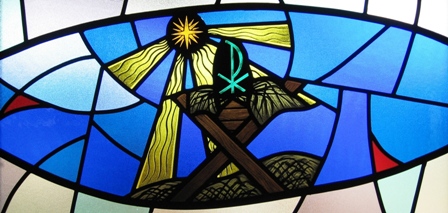
After the Fall man is confronted with the righteous judgment. (“The wages of sin is death.”) For a covenant people, however, there was hope and salvation. To the people of Israel God revealed Himself and came to them in various ways through their history (Old Testament). However, “when the fullness of time came,” in other words, at the right appointed time in history, God came in an altogether unique way. Calling upon a virgin, the angel Gabriel spoke to Mary concerning the conception of the life of the Son of God, and in the humble setting of a stable manger, the Christ Child is born. The star showed the way to the Babe.
TRANSFIGURATION
(Window 4)
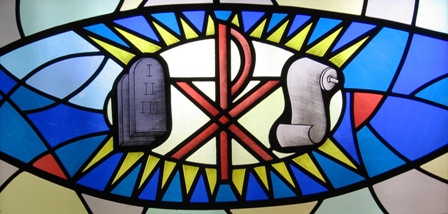
The left center window of the nave with symbols becomes a capstone to the entire window story, even as the transfiguration of our Lord became a capstone in the experience of the Disciples and they sought to relate Christ’s appearance to the Old Testament promises and fulfillment in the New Testament. The brightness of Jesus’ transfiguration with Moses and Elijah flanking the glorified Christ, was so great (sunburst) that Peter, James and John couldn’t look at it. The Word of God at the Baptism of Jesus was heard again at the Transfiguration: “This is my beloved Son in whom I am well pleased.”
CRUCIFIXION
(Window 5)
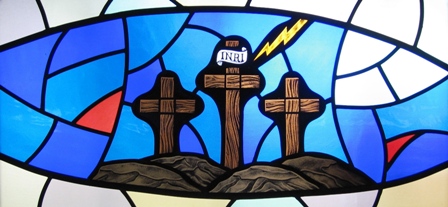
The story of Man began with the responsibility of his having dominion over the created order as the gift of God. In the exercise of his freedom man sought privilege rather than responsibility and suffered separation from God. Then there came a man sent by God who assumed His full responsibility and sought to live by the will of the Father rather than the will of man. Yet, His complete identification with man led to His sharing even in suffering and death the destiny of sinful man, even though He (Jesus) had not sinned. This is the ultimate expression of God’s love (grace) for the world. He becomes the victim in man’s stead, the suffering Lamb (servant) Who alone can take away the sins of the world. “And they led Him to a place called Golgotha (which means the place of a skull) and there they crucified Him.” We are told the heavens turned black and were filled with thunder and lightening. Long years before, God had placed a rainbow in the heavens as a sign of his promised redemption. The fulfillment had come in a man called Jesus and mankind had once again rejected God’s love. Jesus hung dead upon a cross.
RESURRECTION
(Window 6)
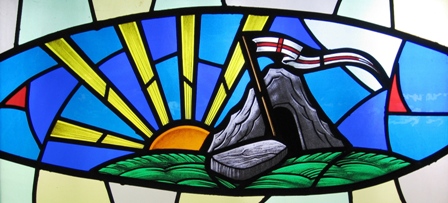
The core of the Gospel, the story of salvation is depicted in the sixth window. Even the grave could not contain the love of God in Christ. The stone is moved away from the tomb door by the angel of the Lord and the Son of God has risen victorious over death and earthly power. Christ is Victor! “He is risen, He is risen indeed!” These words became the rallying cry of the early Church and are the banner heart-beat of the Church to this day. The sun of God’s righteousness in Christ shines forth through the Church and in the world.
PENTECOST
(Window 7)
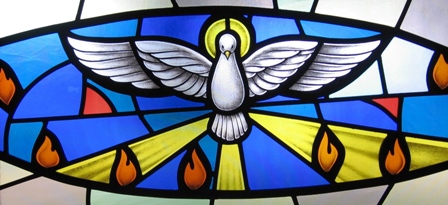
Following the resurrection the disciples gathered in the upper room in a state of prayerful expectancy. The descent of the dove symbolizes the Pentecost event and the presence of the Spirit by the flames of fire which also symbolize the seven-fold gifts of the Spirit. Power is bestowed upon the Church through the living presence of the Spirit of God.
KINGS WINDOW
(Window 8)
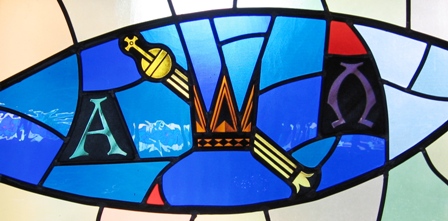
Jesus Christ is our King, our Savior and Leader, first, last and always. “I am the Alpha and the Omega” (the beginning and the end), He says. He is the Head of the Church and the Church will consummate with Him at the end of time in full glory with Him. The crown and the mace are the symbols of His Lordship and leadership.
THE CHURCH
(Window 9)
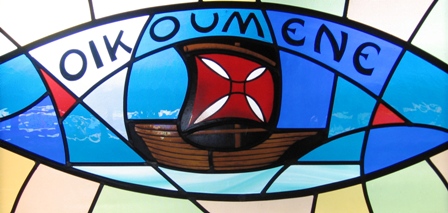
The ninth window symbolizes the Church as a ship on the sea of life. Like those in Noah’s ark, who were saved out of the water, so too are we who are in the ark of the Church saved by virtue of the water of our Baptism into Christ. The Church is Oikoumene (ecumenical), as it has spread and ministers the Gospel to the church buildings look like arks or boats upside down.
THE WORD
(Window 10)
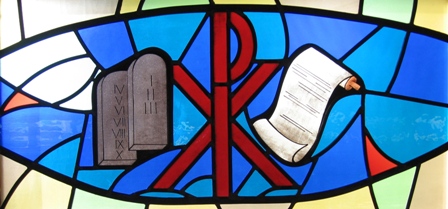
God’s Word in Christ is “the power of God unto salvation”, Paul says. The Lutheran Church has always been known as a Church of the Word – “By Word alone, Grace alone, Faith alone.” God’s Word became flesh among us in Christ. The symbol CHI Rho in window 10 is the symbol for Christ, who was the Promise fulfilled in the Scriptures.
THE SACRAMENTS
(Window 11)
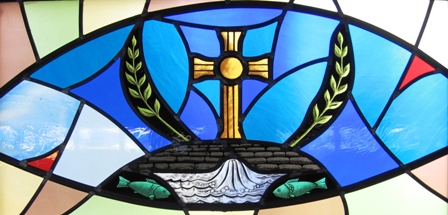
In window 11 we are reminded that the living and ever present Christ is testified to in the Church through the Means of Grace – the Word and the Sacraments. In the Lutheran Church there are two Sacraments which come out of the Word, as commanded by Christ Himself – Baptism and the Lord’s Supper. Window eleven symbolizes Christ as the Bread of Life (Wheat). His blood which we receive in communion was poured out for us on the (Cross). At the foot of the Cross flows the river of life. The water symbolizes our Baptism into Him and the two fish symbolize the number of Sacraments which are food and life to the Christian.
SEAL
(Window 12)
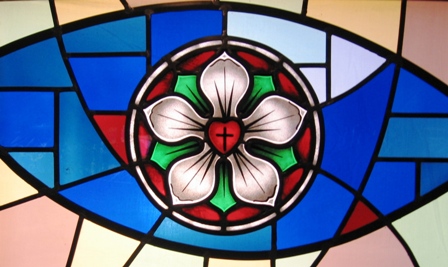
In the last window, Martin Luther devised this seal which he declared was meant to be “expressive of his theology.” It is the centuries long symbol of The Lutheran Church. Here in Luther’s own words is a description of the seal. “…The first thing expressed in my seal is a cross, black, within the heart, to put me in mind that faith in Christ-crucified saves us. ‘For with the heart man believeth unto righteousness.’ Now, although the cross is black, mortified, and intended to cause pain, yet it does not change’ the color of the heart, does not destroy nature — i.e., does not kill, but keeps alive. ‘For the just shall live by faith,’ — by faith in the Savior. But this heart is fixed upon the centre of a white rose, to show that faith causes joy, consolation and peace. The rose is white, not red, because white is the ideal color of all angels and blessed spirits. This rose, moreover, is fixed in a sky — colored ground, to denote that such joy of faith in the spirit is but an earnest and beginning of heavenly joy to come, as anticipated and held by hope, though not yet revealed. And around this groundbase is a golden ring, to signify that such bliss in heaven is endless, and more precious than all joys and treasures, since gold is the best and most precious metal. Christ, our dear Lord, He will give grace unto eternal life. Amen.”
